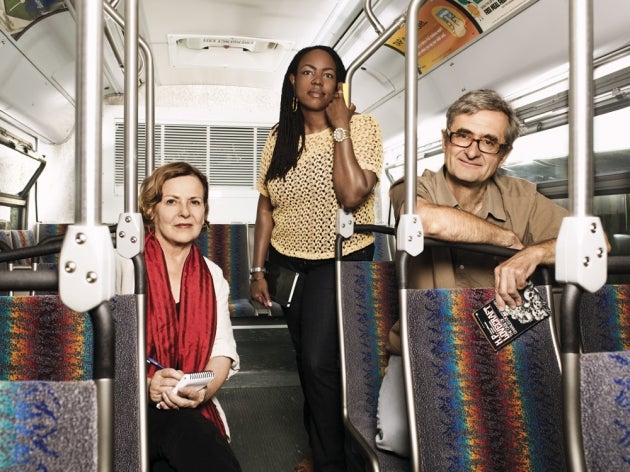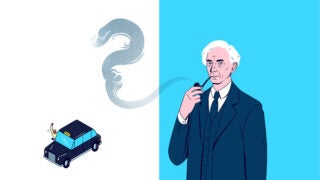Los Angeles by the Book
Three highly regarded USC writers draw from the city’s eccentrics and ordinary folk for their inspiration. But that doesn’t mean they have LA all figured out.
It was the 1970s and Judith Freeman was living in Sun Valley, Idaho, a ski instructor and horse wrangler by day, an aspiring writer by night. She’d never set foot in Los Angeles, yet she knew instinctively she needed to go there to become a serious wordsmith.
“For me, Los Angeles was the only choice,” says the now-established novelist, nonfiction author and USC faculty member. “Not San Francisco. Not Seattle. Los Angeles is the place of reinvention. If you turned America up like a tea kettle and poured it out, this is where we would end up.”
Why LA? Playwright Brighde Mullins, chair of USC’S Master of Professional Writing program, posed that question to fellow authors on a Los Angeles-themed panel at the Los Angeles TimesFestival of Books last spring. Why this place?
For novelist Dana Johnson ’92, an associate professor in English and creative writing at USC, it was purely an accident of birth. Born in South LA and coming of age in nearby West Covina, Johnson can conceive of no other backdrop for her fiction. “All I know is it’s my home,” she says of the city. “I love everything about it. I love the landscape, the culture, the fact that you can’t pin it down.”
For novelist Richard Rayner, a lecturer in USC’s Master of Professional Writing program, it began with an adolescent crush of sorts. Marooned in an “industrial hell-hole,” as he describes his home of Bradford in northern England, Rayner found escape, beauty and solace in the noir fiction of Raymond Chandler and the sunbaked gloom of writers Nathanael West, Christopher Isherwood, Joan Didion and Thomas Pynchon. “I became infatuated with Los Angeles first through books, not movies; I conceived of the city as a literary artifact,” he wrote in a 2011 article for the Los Angeles Review of Books.
The transplant. The native. The expat. Freeman, Johnson and Rayner are but three voices in a chorus of thousands paying cacophonous homage to the city through words. Each different, each seeking to understand Los Angeles, hoping—through keen observation and deft storytelling—to distill its essence.
Watching them at work, you begin to appreciate the enormity of the task.
What London was to the 19th century and New York to the 20th, Los Angeles is to the present day—the meeting place and melting pot of the postmodern world, a sprawling landscape of 10 million souls, exuberantly multiethnic, doggedly multifaith, incomprehensibly polyglot. It all seems so unknowable. Yet novelists do try to know it, intimately, neighborhood by neighborhood, voice by voice.

“Everybody comes to this city for a reason,” says Freeman, who arrived in a pickup truck in 1977. “The trope is to ‘reinvent yourself.’ But what does that really mean? To change yourself from a ski instructor to a writer. A Vietnamese refugee to a doctor. LA is full of yearning—people wanting to transform themselves.”
Freeman’s first novel, The Chinchilla Farm, mirrored her own journey from a narrow Mormon upbringing to the kaleidoscopic variety of LA. “Sometimes an outsider comes at it with a tremendous curiosity and freshness,” she says of her peculiar vantage point on the city, “a willingness to cross all kinds of boundaries.”
She took to the mean streets with fearless abandon, befriending groups of homeless men in Lafayette Park, taking snapshots of drug users, prostitutes and ordinary people on her daily bike rides through the Rampart neighborhood. Marriage to noted Los Angeles photographer Anthony Hernandez, a Boyle Heights native, helped Freeman see in new ways. After 30 years living in their MacArthur Park fat, she knows the area well.
Johnson, as a native Angeleno, didn’t have to go looking for material. She sketched what she’d observed her whole life—the habits of ordinary, working-class people.
“I’m tired of Hollywood,” she complains. “I’m interested in stories that are less about billboards and driving down Sunset Boulevard, about nightclubs and Bimmers. For lots of natives, particularly natives of color or working-class natives, that has nothing to do with anything we know about our hometown.”
As a black writer, she’s also responding to a dearth of stories about the post-civil rights era African-American experience in California. “I feel our challenge as writers is to not do the default thing and write about the familiar territory that’s already been covered,” says Johnson, who teaches fiction workshops and a General Education course on girlhood, and has taught courses on the graphic novel and on ethnic-American literature.
Sitting in her Taper Hall office, behind her sturdy bookshelf overflowing with fiction, her collection of “I Love Lucy” memorabilia artfully arranged on a low cabinet, Johnson seems at ease, on home turf. She is, after all, a USC alumna, and the university is a recurring backdrop in her 2012 debut novel, Elsewhere, California. Ten years in the writing, the book received unanimous praise. It traces a single day in the life of 40-year-old Avery—a beguilingly complicated woman—interspersed with formative memories from her early childhood through young adulthood.
Her current project is set in downtown LA. Still in the early stages of composition, Johnson is mum about the details.
“I’ve lived downtown for eight years now,” she says, “and it’s so different from when I first moved there. I’m really fascinated with the architecture, the history, who lived there when, who moved out when.”
Though best known as the world’s entertainment capital, Los Angeles also has a distinguished literary tradition.
What Charles Dickens did for London, Honoré de Balzac for Paris and James Joyce for Dublin, a trio of Los Angeles authors arguably accomplished in 1939. Raymond Chandler, Nathanael West and John Fante each published an urban masterpiece that year, putting the city firmly on the literary map with The Big Sleep, The Day of the Locust and Ask the Dust.
Freeman, who has taught writing courses at USC since 1996, credits Chandler with revealing the city to her. She returned the favor by revealing Chandler to the city. Her 2012 nonfiction bookThe Long Embrace investigates Chandler’s unconventional marriage to a much-older woman and the couple’s vagabond existence in the Southland, moving more than 40 times in 30 years.
Chandler is a figure of fascination for USC’s Richard Rayner as well. Rayner wrote several detective novels in the 1990s inspired by Chandler’s Philip Marlow mysteries. Rayner’s most recent nonfiction book, A Bright and Guilty Place (2009), resurrects the crime and corruption of Chandler’s day.
Like Rayner and Freeman, Chandler was an outsider. Born in Chicago, he spent his formative years in Great Britain. Both transplant and expat, he transformed himself by some weird alchemy into the troubadour of mid-century LA noir. Elevating the hackneyed genre of detective fiction to new heights, he—along with West, Fante and F. Scott Fitzgerald—pioneered what we now think of as LA literature.
Johnson’s favorite LA writer is also an expat and transplant: Henry Charles Bukowski. The German-born, South LA-reared poet and fiction writer, whom Time magazine dubbed the “laureate of American lowlife,” was the subject of the film Barfy.
“I always thought of LA as having a million different genres of writing,” Rayner says. “There was very obviously the Hollywood novel, the expatriate novel, the immigrant novel, the working-class novel …”
Recently, Rayner was struck anew by the infinite possibilities. He points to one of his MPW students, a young man from a Filipino immigrant family who is currently crafting an LA gay novel.
“We’re going to go on seeing more and more definitions of what the LA novel can be,” Rayner says. “It can be anything.”
As Freeman puts it, “Writers are gleaners—we gather material.” And in Los Angeles, there’s no better place to glean than the city bus. She, Rayner and Johnson each regularly climb aboard Metro, ears primed and notebook in hand.
“When you are on the bus, you really hear the voices of the city,” Freeman says. A novel with the working title Bus has long been on her to-do list.
Rayner’s first novel, LA Without a Map, is heavily indebted to public transportation. Based on the author’s real-life fling with a Playboy bunny—“a love affair gone horribly wrong, like a Marx Brothers comedy”—the novel conjoins the love affair with many notebooks’ worth of reporting he did on the bus. He likens the final product to “Evelyn Waugh meets Hunter S. Thompson.”
For Rayner, riding the bus was a matter of necessity, not choice. He never learned to drive. In his earliest LA writing gigs, celebrity interviews for Time Out magazine, glitz collided with grit on his long bus rides from downtown to Bel Air. “Without thinking about it at the time, I knew this was a very good way to see the city,” Rayner says. His passenger’s-eye view of the city grew darker as a breaking news assignment found him riding through South LA during the 1992 LA riots. Later, a 1995 investigative piece for the New York Times Magazine landed him and a photographer in the backseat of police squad cars.
“We spent two weeks in Venice waiting for a murder to happen, and then when we got to Rampart we saw someone die in front of our eyes in 30 seconds,” he says of that experience. His books fed of his reporting, moving into the realm of detective fiction and true-crime histories. But Hollywood still fascinates Rayner, who is married to Finnish filmmaker Paivi Suvilehto. (Their oldest son is now a sophomore at USC, double-majoring in music and international relations.)
Today, Rayner has one foot in the literary world, the other in Hollywood. His last nonfiction book, A Bright and Guilty Place, was optioned by Christopher Nolan (of Man of Steel and theDark Knight trilogy). His current project resurrects the brilliant but wildly controversial filmmaker D.W. Griffith, and it’s already been optioned by filmmaker Paul Greengrass (Bloody Sunday, theBourne series), a college friend of Rayner’s from Cambridge.
But writing about this city is more than noir, grit, glitz, the ordinarily everyday and the extraordinarily bizarre. “LA writing means so many different things,” says Rayner.
Like the city itself, the literature only gets richer and harder to pin down.



